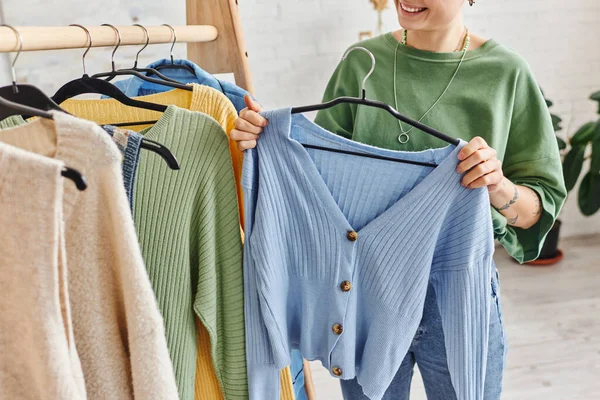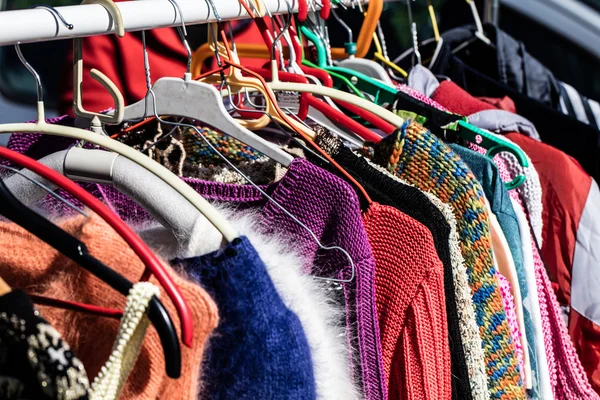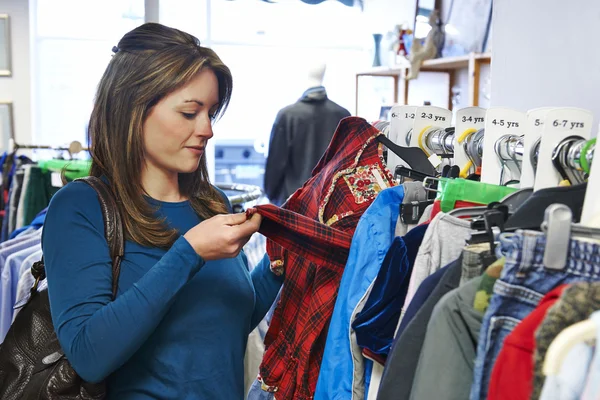Thrift flipping has emerged as a remarkably profitable venture. You can tell that the allure lies not only in the potential for financial gain but also in the satisfaction of transforming discarded items into sought-after pieces.
Thrift flippers tap into a market that values uniqueness and sustainability by breathing new life into overlooked pieces. The growing appreciation for vintage and repurposed items fuels the resale potential for upcycled goods.
Moreover, as consumers increasingly prioritize environmentally conscious choices, thrift flipping aligns seamlessly with the ethos of recycling and reducing waste.
In essence, thrift flipping transcends the ordinary, as it offers a gateway to financial gains while championing sustainability and creativity.
To learn how to flip thrift store items and make some extra cash, scroll down!

Key Takeaway
- Thrift flipping involves finding overlooked items at thrift stores and flea markets and reselling them for a profit through strategic upgrades and savvy marketing. It allows flippers to tap into the growing market for unique, vintage, and sustainable goods.
- Building relationships with store managers to get bulk deals and early access to inventory is crucial. Volunteering during off-hours can establish connections. Social media also serves as a powerful tool to connect with buyers.
- Knowing current market prices and trends is essential to evaluate properly and price items. Bundling complementary products together increases perceived value.
- Effective listings and cross-posting across platforms expand your reach. The software helps to list many items efficiently. Creative upgrades boost appeal and value.
Sourcing Valuable Inventory – Items To Flip

The allure of this method lies in its agility – thrift flippers can capitalize on discounted items, often in excellent condition, before they disappear from the shelves.
Here are some tips for you:
Stay informed about department store clearance cycles and sales events
This is one of the best ways to excel in this method. Using online marketplaces as selling platforms widens the reach. This allows thrift flippers to connect with a diverse range of potential buyers.
Moreover, building relationships with department store managers can open doors to exclusive opportunities for sourcing valuable inventory.
Volunteer off the clock
This provides a unique way to establish connections, assisting with tasks like sorting merchandise during non-working hours. This can lead to gaining VIP access to newly stocked items.
Build relationships for bulk deal negotiating
Did you know? Bulk deals can be a game-changer. Building relationships with store decision-makers is crucial for negotiating discounts when purchasing high-value items in large batches.
This method goes beyond the traditional one-item-at-a-time approach.
Developing these trusted partnerships involves consistent communication, a clear understanding of the store’s inventory management, and a commitment to ethical and fair business practices.
Guess what? When store managers recognize a thrift flipper’s reliability and integrity, they are often more willing to negotiate favorable terms for bulk purchases.
Social media serves as a powerful tool for thrift flippers. This allows them to showcase their curated collections and connect with a community of like-minded individuals who share a passion for repurposing and reimagining.
The art of thrift flipping extends beyond merely buying and selling – it’s about strategic sourcing, relationship-building, and navigating the evolving landscape of consumer preferences.
By mastering the techniques of speed sourcing, volunteering for VIP access, and negotiating bulk deals, thrift flippers can carve a niche in the thriving world of second-hand treasures, turning their passion for good items into a sustainable and profitable side hustle.
Evaluating & Pricing Your Thrift Store Purchases

Staying informed about market trends and pricing is crucial for thrift flippers looking to maximize their profits.
Understanding the current demand and pricing for popular brands is essential for those venturing into the world of new clothing.
Browser extensions to instantly evaluate sales data
Browser extensions allow thrift flippers to gauge how much money similar items are fetching on various online platforms like Tradesy or Poshmark. Moreover, these extensions become even more indispensable when considering the shipping costs of selling items online.
This approach transforms thrift flipping from a casual endeavor into a potential full-time income source.
Bundle complementary items for more profit
The innovative strategy of bundling complementary items can help maximize returns. Rather than selling individual pieces separately, thrift flippers can create sets or packages of related products.
This adds value for buyers and allows thrift flippers to command a higher price, translating into much money for the entire bundle.
Bundling works exceptionally well when dealing with items in good shape that complement each other.
For example, pairing a vintage jacket with a matching accessory or bundling a kitchenware set with coordinating items can attract buyers looking for a complete and curated experience.
Garage Sales Can Be Great For Finding Items Worth Buying and Bundling
Thrift flippers can source various reasonably priced items, creating bundles that cater to different tastes and preferences. This diverse approach allows thrift flippers to appeal to a broader audience and increase their chances of making a profit.
Mastering the art of evaluating and pricing thrifted items is essential for thrift flippers aiming to turn their passion into a lucrative venture.
Whether dealing with new clothing, popular brands, or garage sale finds, these strategies empower thrift flippers to navigate the thrift-flipping landscape confidently, making strategic decisions that contribute to their financial success and the satisfaction of their customers.
Listing & Selling Finds – Flip For Profit, Sell Online
 l
l
Scaling Up Your Flipping Business

Scaling up your flipping business involves strategic steps to manage inventory, transition from a side hustle to a full-time occupation, and navigate the intricacies of reselling.
Here are essential considerations to elevate your thrift-flipping venture.
- Effective inventory management is pivotal for scaling up your flipping business. Whether dealing with high-quality or popular items in this category, maintaining an organized system for listed and sourced products is key.
- Physical tracking is equally important, especially when dealing with many items from thrift stores, estate sales, or other sources. Implement a system for categorizing, labeling, and storing items to streamline your workflow.
- Always make sure to monitor the turnover of items, especially in many thrift stores where new inventory arrives regularly. Lower prices for items that have been in your inventory for an extended period to maintain a healthy and dynamic product selection.
- To turn your thrift-flipping passion into a full-time venture, consider the transition from a hobby to a business. This involves obtaining necessary documentation such as tax IDs and licensing.
- Explore the legal requirements in your area for reselling second-hand items. Many thrift stores might be able to provide insights or recommendations based on their own experiences. Establish a clear understanding of tax obligations, and consider consulting with a professional to ensure compliance with local regulations.
Remember that consistently sourcing popular items and maintaining high-quality standards contribute to long-term success!
This transition allows you to make extra money by turning a beloved hobby into a sustainable and profitable full-time occupation.
Avoiding Common Mistakes Thrift Store Flipping

From watching out for fees that can eat into profits to not getting carried away with decluttering too fast, here are essential tips to ensure your reselling business thrives – especially if you’re using LuLaRoe.
- One of the most common mistakes in the reselling business is underestimating the impact of fees on your profit margin. High prices and high demand for items may seem promising, but expenses like shipping supplies, selling platform commissions, and taxes can significantly diminish your earnings.
- Always factor in all associated costs when determining the selling price for your items. This includes considering the shipping fees, packaging materials, and any commissions charged by the platform where you list your items. Staying vigilant about fees allows you to set prices that attract buyers and ensure you profit after all expenses are accounted for.
- While the goal of decluttering is admirable, rushing to resell every item in an effort to clear clutter may lead to overlooking valuable finds. Items in a thrift store may seem ordinary at first glance, but a careful inspection could reveal hidden treasures. To avoid this mistake, take the time to thoroughly assess each item’s condition and potential value before deciding to sell it. Even in good condition, some items may not have high demand or fetch high prices.
- Using accounting tools, such as apps that log costs of goods, fees, membership dues, and other expenditures, helps you calculate your true profit accurately. Plus, when it’s time to report your income, there are plenty of free tax filing tools that can help you stay compliant without added costs—especially for those just starting out or working on a tight budget.
- Purchasing items from thrift stores may offer a cost-effective inventory, but it’s essential to account for all expenses incurred during reselling. Regularly reviewing your financial data allows you to make informed decisions and adjust your strategies for improved profitability.
You can turn your love for thrifting into a thriving and sustainable business that offers a little different, yet profitable, perspective on household items.
Making Use of Loyalty Programs

Loyalty programs can be powerful tools for thrift flippers. Here’s how to make the most of these programs:
Stack Discounts and Membership Perks for Best Deals
Combine the power of coupons, sales, and VIP rewards to unlock the maximum savings potential at thrift store chains or flea markets.
Many stores offer loyalty programs with tiered membership levels, providing increasing benefits as you spend more.
Stack these discounts strategically to amplify your savings and improve the profit margin on items you plan on flipping.
Take Advantage of Special Sales and VIP Early Access
Keep a close eye on thrift store chains or flea markets for special sales and VIP events. Loyalty program members often gain early access to these high-discount days, providing an opportunity to snag the easiest items or box sets before the general public.
Whether exclusive discounts or first dibs on new inventory, taking advantage of these perks can set you up for successful flipping.
In your free time, make it a habit to visit thrift stores regularly, and always be on the lookout for items that sell well. Loyalty programs can turn your thrifting hobby into a more lucrative venture, especially when flipping items online.
Stay engaged with the best places that offer loyalty rewards, and watch your profits grow as you leverage these programs to their fullest potential.
Extra Tips For Thrift Store Flipping – Boost Earnings
Here are some extra tips to elevate your flipping game:
- Refresh Old Listings Regularly: Don’t let your listings fade into obscurity. Regularly refresh old listings by updating the dates. Especially for well-known brands, keeping your items at the forefront ensures they catch the eye of potential buyers.
- Stay Organized with Detailed Inventory Notes: Maintain meticulous records of your inventory. Whether through digital tools or physical notes, keep track of the cost of items, listed prices, and associated fees. Stay organized to make informed decisions about pricing and sourcing.
- Reinvest Profits into More Valuable Flips: As your thrift-flipping endeavors generate profits, consider reinvesting them strategically. Look for higher-profit items to scale up your business. By continually buying and flipping more valuable items, you increase the potential for higher earnings.
Thrifting for profit involves a keen eye for the best places to find items to resell. While thrift store flipping isn’t just about stuff to flip, it’s about understanding the items that hold value.
From antique items to well-known brands, the higher your profit, the more opportunities you have to reinvest in even greater items.
Incorporating these extra tips into your thrift-flipping strategy can substantially impact your earnings.
Keep a constant eye out for great items in the best places to find treasures, and leverage your profits wisely to elevate your thrift-flipping business continually.
Whether you started with thrift store flipping as a hobby or are actively seeking the easiest items to flip for profit, these tips contribute to long-term success in the dynamic world of reselling.
How To Flip Thrift Store Items – Conclusion
Thrifting flipping, the art of turning overlooked items into sought-after treasures, involves strategic sourcing, creative upgrades, and savvy marketing to unlock the full potential of thrift store finds.
From vintage items to well-known brands, the journey of thrift flipping offers a different perspective, transforming a beloved hobby into a sustainable and profitable side hustle.
In thrift stores and reselling, thrift flippers delve into a world where customer service meets creativity. This eco-conscious pursuit aligns seamlessly with sustainability, resonating with a growing market that values uniqueness and the story behind each find.
Loyalty programs, extra tips to boost earnings, and careful avoidance of common mistakes are integral to a successful thrift-flipping venture.
As thrift flippers refresh old listings, stay organized with detailed inventory notes, and reinvest profits into more valuable flips, they witness the transformation of a passion into a thriving business.
Thrift store flipping isn’t just about stuff to flip; it’s about understanding the value in vintage items, good profit margins, and the joy of curating treasures that resonate with a diverse audience.
Every vintage find is a story, and every successful sale is a testament to the art of turning the ordinary into the extraordinary.

